Simulation Studies on Centrifugal MQL-CCA Method of Applying Coolant during Internal Cylindrical Grinding Process
Abstract
1. Introduction
- the possibilities of increasing the coolant’s penetration efficiency directly into the GWAS contact zone with the workpiece surface;
- the possibilities of reducing the number of coolants used in the grinding process;
- the elimination of the need to use coolants by looking for new media.
2. Characteristic of the Centrifugal MQL-CCA Method of Applying Coolant during Internal Cylindrical Grinding Process
- six-nozzle omnidirectional minimum quantity lubrication head type ZR-K 360°;
- MQL head supply system with compressed air and oil from the workpiece spindle side;
- special design grinding wheel arbor;
- system for fixing the ZR-K 360° head stationary inside the rotating grinding wheel arbor;
- special ceramic grinding wheel with dimensions 40 mm × 20 mm × 26 mm adapted to work with hollow grinding arbor;
- as a lubricant, an oil called Cimtech® MQL from CIMCOOL® Fluid Technology, part of Milacron LLC, was used.
3. Simulation Tests of Coolant Flow and Heat Transfer in the Grinding Zone
- the geometry of the grinding arbor (three variants of arrangement and number of channels on its circumference);
- the angle of inclination of the outlets of the CCA supply line to the grinding zone (three angle values);
- the peripheral speed of the grinding wheel vs and workpiece vw (three values of vs and vw speed).
3.1. Methodology of Simulation Tests
- number of channels in grinding arbor for air-oil aerosol centrifugal delivery: nchannels = 3, 6, 9;
- the diameter of a single channel in the grinding arbor for air-oil aerosol delivery depended on their number in such a way that the total area of the channels cross-sectional area is constant: dchannels = 5.00 mm (for nchannels = 9); 6.12 mm (for nchannels = 6); 8.66 mm (for nchannels = 3);
- alignment angle in the z axis of the CCA supply line outlets: α1 = α2 = 10.0°; 12.5°; 15.0°;
- peripheral speed of grinding wheel: vs = 40 m/s; 50 m/s; 60 m/s;
- peripheral speed of the workpiece (speed ratio q = vs/vw was taken as constant: q = 60): vw = 0.67 m/s, 0.83 m/s, 1.00 m/s.
3.2. Mathematical Model
- Cd—mass density of dispersed phase,
- F—additional volumetric forces,
- p—pressure,
- t—time,
- u—velocity,
- uslide—velocity in-between phases,
- μ—dynamic viscosity,
- μT—turbulent viscosity,
- ρ—density;
- ρc—density of continuous phase,
- ρd—density of dispersed phase,
- φc—volumetric share of continuous phase,
- φd—volumetric share of dispersed phase;
- Dmd—diffusion coefficient of dispersed phase in a fluid,
- mdc—mass transfer between phases.
- dd—diameter of dispersed phase,
- fd—coefficient of flow resistance for dispersed phase.
- k—kinetic energy,
- β, σk—model constants;
- Pk—turbulence production,
- σω—model constant,
- ω—turbulent frequency.
3.3. The Results of Simulation Tests and Their Analysis
- number of channels in grinding arbor for air-oil aerosol centrifugal delivery: nchannels = 9;
- the diameter of a single channel in the grinding arbor for air-oil aerosol centrifugal delivery: dchannels = 5.00 mm;
- alignment angle in the z axis of the CCA supply line outlets: α1 = α2 = 15.0°;
- peripheral speed of grinding wheel: vs = 60 m/s;
- peripheral speed of the workpiece: vw = 1.00 m/s.
4. Conclusions
- Simulation studies showed that both the number of channels in the grinding arbor nchannels and the angle of inclination of the CAG nozzle outlets α have a significant impact on the coolant flow rate and thermal conditions in the grinding zone.
- The results of the simulation tests indicate that a larger number of channels in the grinding arbor (from the range under test) has the effect of increasing the maximum coolant flow velocity (air flow velocity and oil flow velocity) in the grinding zone due to a local increase in the oil and air particle flow velocity in the volume of the grinding arbor channels, which was caused by the smaller value of the cross-sectional area of a single channel through which the coolant flowed.
- Variants of the system with nine channels in the grinding arbor allowed for a noticeable reduction in the temperature of the workpiece, which resulted from a more even distribution of the air-oil aerosol on the perimeter of the inner cylindrical surface of the workpiece domain, in relation to variants with six and three channels in the grinding arbor.
- The 15° angle of inclination of the CAG supply line outlets affects the concentration of the greater part of the high-speed CCA jet on the surface of the grinding wheel, which enables increased cooling efficiency. The 10° inclination of the CAG supply line outlets affects the concentration of the greater part of the CCA jet on the workpiece surface, which enables an increased efficiency of workpiece cooling.
- As the peripheral speed of the grinding wheel domain increased (in the examined range), the maximum flow speed of the coolant in the grinding zone and the cooling efficiency of both the grinding wheel domain and the workpiece increased.
- The lower speed of the air-oil aerosol flow through the intergranular spaces translates into less effective heat removal from the grinding wheel body.
- The results obtained for the simulation tests made it possible to visualise the velocity vectors of the two-phase coolant flow in a complex system of centrifugal air-oil aerosol delivery through an open structure of a very fast rotating porous layer (grinding wheel), with an additional CCA supply using an external CAG nozzle, which is an important cognitive aspect and allows for further development of research in this field.
- The simulation tests carried out enabled a precise selection of the conditions for delivery the coolant to the grinding zone for further experimental testing of the analysed internal cylindrical grinding process. The results of experimental research are described in detail in the paper [60]. They confirm that with the application of the most advantageous process conditions resulting from the simulation tests it is possible to achieve effective penetration of cooling and lubricating agents into the grinding zone. Moreover, it was proved that directing the CCA stream directly behind the grinding wheel’s contact zone with the machined material effectively cleans the working area from chips, thus limiting the phenomenon of clogging of the GWAS.
Author Contributions
Funding
Conflicts of Interest
Nomenclature
| Symbols | |
| ae | working engagement (machining allowance), mm |
| Achannels | summary cross-sectional area of the channels in the grinding arbor, mm2 |
| Cd | mass density of dispersed phase, kg/m |
| dchannels | grinding arbor channels diameter, mm |
| ds | grinding wheel outer diameter, mm |
| dw | workpiece internal diameter, mm |
| Dmd | diffusion coefficient of dispersed phase in a fluid, m/s2 |
| F | additional volumetric forces, N/kg |
| fd | coefficient of flow resistance for dispersed phase |
| G | grinding ratio |
| mdc | mass transfer between phases |
| nchannels | number of channels in the grinding arbor |
| ns | grinding wheel rotational speed, rpm |
| nw | workpiece rotational speed, rpm |
| p | pressure, Pa |
| Pk | turbulence production |
| q | speed ratio q = vs/vw |
| QCCA | compressed cold air flow rate, dm3/min |
| R | multidimensional correlation coefficient |
| RGWAS | roughnes of the grinding wheel active surface |
| t | time, s |
| T | temperature, °C |
| TGWAS | temperature of the heat source on the external surface of the grinding wheel, °C |
| Tw | temperature of the heat source on the internal surface of the workpiece, °C |
| u | velocity, m/s |
| U | work, J |
| uslide | velocity in-between phases, m/s |
| uτ | friction velocity, m/s |
| vc | volume of continuous phase, m3 |
| vCCA | compressed cooled air flow rate, m/s |
| vd | volume of dispersed phase, m3 |
| vfo | axial feed velocity of the grinding wheel, mm/s |
| vfr | radial feed velocity of the grinding wheel, mm/s |
| vMQL | air-oil aerosol flow rate, m/s |
| vs | grinding wheel peripheral speed, mm/s |
| vw | workpiece peripheral speed, mm/s |
| Greek symbols | |
| α1 | alignment angle of compressed cooled air supply line outlet no. 1, ° |
| α2 | alignment angle of compressed cooled air supply line outlet no. 2, ° |
| β | model constant |
| ε | dissipation rate of turbulent energy |
| ΘGWAS max | maximum grinding wheel temperature, °C |
| ΘGWAS min | minimum grinding wheel temperature, °C |
| Θw max | maximum workpiece temperature, °C |
| Θw min | minimum workpiece temperature, °C |
| μ | dynamic viscosity, Pa·s |
| μT | turbulent viscosity, Pa·s |
| ν | kinematic viscosity, m2/s |
| ρ | density, kg/m3 |
| ρc | density of continuous phase, kg/m3 |
| ρd | density of dispersed phase, kg/m3 |
| σk | model constant |
| σω | model constant |
| φc | volumetric share of continuous phase |
| φd | volumetric share of dispersed phase |
| ω | turbulent frequency |
| Acronyms | |
| CAG | Cold Air Gun |
| CAMQL | Cold Air Minimum Quantity Lubrication |
| CAOM | Cold Air and Oil Mist |
| CCA | Compressed Cooled Air |
| CFD | Computational Fluid Dynamics |
| GWAS | Grinding Wheel Active Surface |
| MMRO | Mathematical Model of the Research Object |
| MQC | Minimum Quantity Cooling |
| MQCL | Minimum Quantity Cooling Lubrication |
| MQL | Minimum Quantity Lubrication |
References
- Marinescu, I.D.; Hitchiner, M.; Uhlmann, E.; Rowe, W.B.; Inasaki, I. Handbook of Machining with Grinding Wheels; CRC Press: Boca Raton, FL, USA, 2007. [Google Scholar]
- Marinescu, I.; Rowe, W.B.; Dimitrov, A.B.; Inasaki, I.; Dimitrov, B. Tribology of abrasive machining processes. J. Manuf. Sci. Eng. 2004, 126, 859. [Google Scholar] [CrossRef]
- Jackson, M.J.; Davim, J.P. Machining with Abrasives; Springer: New York, NY, USA, 2010. [Google Scholar]
- Klocke, F. Manufacturing Processes 2, Grinding, Honing, Lapping; Springer: Berlin/Heidelberg, Germany, 2009. [Google Scholar]
- Kapłonek, W.; Nadolny, K. The diagnostics of abrasive tools after internal cylindrical grinding of hard-to-cut materials by means of a laser technique using imaging and analysis of scattered light. Arab. J. Sci. Eng. 2012, 38, 953–970. [Google Scholar] [CrossRef]
- Kapłonek, W.; Nadolny, K.; Hloch, S. The use of opto-digital microscope for analysis Of the PFA-based abrasive tools with surface micro-discontinuities. Niger. J. Technol. 2014, 33, 125. [Google Scholar] [CrossRef][Green Version]
- Nadolny, K. Micro-discontinuities of the grinding wheel and their effects on its durability during internal cylindrical grinding. Mach. Sci. Technol. 2013, 17, 74–92. [Google Scholar] [CrossRef]
- Nadolny, K.; Habrat, W. Potential for improving efficiency of the internal cylindrical grinding process by modification of the grinding wheel structure—Part I: Grinding wheels made of conventional abrasive grains. Proc. Inst. Mech. Eng. Part E J. Process. Mech. Eng. 2016, 231, 621–632. [Google Scholar] [CrossRef]
- Nadolny, K.; Habrat, W. Potential for improving efficiency of the internal cylindrical grinding process by modification of the grinding wheel structure: Part II: Grinding wheels made of superabrasive grains. Proc. Inst. Mech. Eng. Part E J. Process. Mech. Eng. 2016, 231, 813–823. [Google Scholar] [CrossRef]
- Nadolny, K.; Kapłonek, W.; Ungureanu, N. Effect of macro-geometry of the grinding wheel active surface on traverse internal cylindrical grinding process. J. Mech. Energy Eng. 2017, 1, 15–22. [Google Scholar]
- Nadolny, K.; Al-Obaidi, A.S.M. A multi-criteria methodology for effectiveness assessment of internal cylindrical grinding process with modified grinding wheels. Int. J. Adv. Manuf. Technol. 2016, 87, 625–637. [Google Scholar] [CrossRef][Green Version]
- Wójcik, R.; Nadolny, K. The effect of the grinding wheel modification on the state of the workpiece surface layer after internal cylindrical grinding of steel C45. Proc. Inst. Mech. Eng. Part E J. Process. Mech. Eng. 2016, 231, 1162–1173. [Google Scholar] [CrossRef]
- Astakhov, V.P. Tribology of Metal Cutting; Elsevier: Oxford, UK, 2006. [Google Scholar]
- Klocke, F. Manufacturing Processes 1; Springer Science and Business Media LLC: Berlin/Heidelberg, Germany, 2011. [Google Scholar]
- Davim, J.P. Machining: Fundamentals and Recent Advances; Springer: London, UK, 2008; pp. 195–223. [Google Scholar]
- Hadad, M. An experimental investigation of the effects of machining parameters on environmentally friendly grinding process. J. Clean. Prod. 2015, 108, 217–231. [Google Scholar] [CrossRef]
- Bianchi, E.C.; Rodriguez, R.L.; Hildebrandt, R.A.; Lopes, J.C.; De Melo, H.J.; Da Silva, R.B.; De Aguiar, P.R. Plunge cylindrical grinding with the minimum quantity lubrication coolant technique assisted with wheel cleaning system. Int. J. Adv. Manuf. Technol. 2017, 95, 2907–2916. [Google Scholar] [CrossRef]
- Bianchi, E.C.; Sato, B.K.; Sales, A.R.; Lopes, J.C.; De Melo, H.J.; Sanchez, L.E.D.A.; Diniz, A.E.; Aguiar, P.R. Evaluating the effect of the compressed air wheel cleaning in grinding the AISI 4340 steel with CBN and MQL with water. Int. J. Adv. Manuf. Technol. 2017, 95, 2855–2864. [Google Scholar] [CrossRef]
- Hadad, M.; Sharbati, A. Thermal aspects of environmentally friendly-mql grinding process. Procedia CIRP 2016, 40, 509–515. [Google Scholar] [CrossRef]
- Huang, X.; Ren, Y.; Jiang, W.; He, Z.; Deng, Z. Investigation on grind-hardening annealed AISI5140 steel with minimal quantity lubrication. Int. J. Adv. Manuf. Technol. 2016, 89, 1069–1077. [Google Scholar] [CrossRef]
- Morgan, M.; Barczak, L.M.; Batako, A.D. Temperatures in fine grinding with minimum quantity lubrication (MQL). Int. J. Adv. Manuf. Technol. 2011, 60, 951–958. [Google Scholar] [CrossRef]
- Da Silva, L.R.; Bianchi, E.C.; Catai, R.E.; Fusse, R.Y.; França, T.V.; Aguiar, P.R. Study on the behavior of the minimum quantity lubricant—MQL technique under different lubricating and cooling conditions when grinding ABNT 4340 steel. J. Braz. Soc. Mech. Sci. Eng. 2005, 27, 192–199. [Google Scholar] [CrossRef]
- Silva, L.R.; Bianchi, E.C.; Fusse, R.Y.; Catai, R.E.; Franca, T.V.; Aguiar, P.R. Analysis of surface integrity for minimum quantity lubricant—MQL in grinding. Int. J. Mach. Tools and Manuf. 2007, 47, 412–418. [Google Scholar] [CrossRef]
- Tawakoli, T.; Hadad, M.J.; Sadeghi, M.H. Influence of oil mist parameters on minimum quantity lubrication—MQL grinding process. Int. J. Mach. Tools Manuf. 2010, 50, 521–531. [Google Scholar] [CrossRef]
- Tawakoli, T.; Hadad, M.; Sadeghi, M.H. Investigation on minimum quantity lubricant-MQL grinding of 100Cr6 hardened steel using different abrasive and coolant–lubricant types. Int. J. Mach. Tools Manuf. 2010, 50, 698–708. [Google Scholar] [CrossRef]
- Tawakoli, T.; Hadad, M.; Sadeghi, M.H.; Daneshi, A.; Sadeghi, B. Minimum quantity lubrication in grinding: Effects of abrasive and coolant–lubricant types. J. Clean. Prod. 2011, 19, 2088–2099. [Google Scholar] [CrossRef]
- Zhang, Y.; Li, C.; Jia, D.; Zhang, D.; Zhang, X. Experimental evaluation of MoS2 nanoparticles in jet MQL grinding with different types of vegetable oil as base oil. J. Clean. Prod. 2015, 87, 930–940. [Google Scholar] [CrossRef]
- Zhang, D.; Li, C.; Zhang, Y.; Jia, D.; Zhang, X. Experimental research on the energy ratio coefficient and specific grinding energy in nanoparticle jet MQL grinding. Int. J. Adv. Manuf. Technol. 2015, 78, 1275–1288. [Google Scholar] [CrossRef]
- Barczak, L.; Batako, A.D.; Morgan, M. A study of plane surface grinding under minimum quantity lubrication (MQL) conditions. Int. J. Mach. Tools Manuf. 2010, 50, 977–985. [Google Scholar] [CrossRef]
- Chakule, R.R.; Chaudhari, S.S.; Talmale, P.S. Evaluation of the effects of machining parameters on MQL based surface grinding process using response surface methodology. J. Mech. Sci. Technol. 2017, 31, 3907–3916. [Google Scholar] [CrossRef]
- Rabiei, F.; Rahimi, A.; Hadad, M.; Ashrafijou, M. Performance improvement of minimum quantity lubrication (MQL) technique in surface grinding by modeling and optimization. J. Clean. Prod. 2015, 86, 447–460. [Google Scholar] [CrossRef]
- Sadeghi, M.H.; Hadad, M.J.; Tawakoli, T.; Vesali, A.; Emami, M. An investigation on surface grinding of AISI 4140 hardened steel using minimum quantity lubrication-MQL technique. Int. J. Mater. Form. 2010, 3, 241–251. [Google Scholar] [CrossRef]
- Batako, A.D.; Tsiakoumis, V. An experimental investigation into resonance dry grinding of hardened steel and nickel alloys with element of MQL. Int. J. Adv. Manuf. Technol. 2014, 77, 27–41. [Google Scholar] [CrossRef]
- Hadad, M.; Hadi, M. An investigation on surface grinding of hardened stainless steel S34700 and aluminum alloy AA6061 using minimum quantity of lubrication (MQL) technique. Int. J. Adv. Manuf. Technol. 2013, 68, 2145–2158. [Google Scholar] [CrossRef]
- Sadeghi, M.H.; Haddad, M.J.; Tawakoli, T.; Emami, M. Minimal quantity lubrication-MQL in grinding of Ti–6Al–4V titanium alloy. Int. J. Adv. Manuf. Technol. 2008, 44, 487–500. [Google Scholar] [CrossRef]
- Wójcik, R.; Nadolny, K. The effects of a variety of cutting fluids administered using the minimum quantity lubrication (MQL) method on the surface grinding process for nickel-based alloys. J. Zhejiang Univ. 2017, 18, 728–740. [Google Scholar] [CrossRef]
- Klocke, F.; Gerschwiler, K. Minimalmengenschmierung–Systeme, Medien, Einsatzbeispiele und okonomische Aspekte der Trockenbearbeitung, Trocken-bearbeitung von Metallen. In Proceedings of the VDI-Seminar, Stuttgart, Germany, 18–18 March 2003; pp. 2.1–2.20. [Google Scholar]
- Priarone, P.C.; Robiglio, M.; Settineri, L.; Tebaldo, V. Effectiveness of minimizing cutting fluid use when turning difficult-to-cut alloys. Procedia CIRP 2015, 29, 341–346. [Google Scholar] [CrossRef]
- Weinert, K.; Inasaki, I.; Sutherland, J.; Wakabayashi, T. Dry machining and minimum quantity lubrication. CIRP Ann. 2004, 53, 511–537. [Google Scholar] [CrossRef]
- Ayoama, T. Development of a mixture supply system for machining with minimal quantity lubrication. Ann. CIRP 2002, 51, 289–292. [Google Scholar] [CrossRef]
- Chandrasekaran, H.; Thuvander, A. Modelling tool stresses and temperature. Evaluation in turning using FEM. Mach. Sci. Technol. 1998, 2, 355–367. [Google Scholar] [CrossRef]
- Machado, A.R.; Wallbank, J. The effect of extremely low lubricant volumes in machining. Wear 1997, 210, 76–82. [Google Scholar] [CrossRef]
- Zhang, S.; Li, J.; Wang, Y. Tool life and cutting forces in end milling Inconel 718 under dry and minimum quantity cooling lubrication cutting conditions. J. Clean. Prod. 2012, 32, 81–87. [Google Scholar] [CrossRef]
- Maruda, R.W.; Feldshtein, E.; Legutko, S.; Krolczyk, G.M. Analysis of contact phenomena and heat exchange in the cutting zone under minimum quantity cooling lubrication conditions. Arab. J. Sci. Eng. 2015, 41, 661–668. [Google Scholar] [CrossRef]
- Maruda, R.W.; Krolczyk, G.M.; Feldshtein, E.; Pusavec, F.; Szydlowski, M.; Legutko, S.; Sobczak-Kupiec, A. A study on droplets sizes, their distribution and heat exchange for minimum quantity cooling lubrication (MQCL). Int. J. Mach. Tools Manuf. 2016, 100, 81–92. [Google Scholar] [CrossRef]
- Maruda, R.W.; Krolczyk, G.M.; Michalski, M.; Nieslony, P.; Wojciechowski, S. Structural and microhardness changes after turning of the aisi 1045 steel for minimum quantity cooling lubrication. J. Mater. Eng. Perform. 2016, 26, 431–438. [Google Scholar] [CrossRef]
- Maruda, R.W.; Legutko, S.; Krolczyk, G.M.; Raos, P. Influence of cooling conditions on the machining process under MQCL and MQL conditions. Teh. Vjesn. Tech. Gaz. 2015, 22, 965–970. [Google Scholar] [CrossRef]
- Hadad, M.; Tawakoli, T.; Sadeghi, M.H.; Sadeghi, B. Temperature and energy partition in minimum quantity lubrication-MQL grinding process. Int. J. Mach. Tools Manuf. 2012, 54, 10–17. [Google Scholar] [CrossRef]
- Saberi, A.; Rahimi, A.; Parsa, H.; Ashrafijou, M.; Rabiei, F. Improvement of surface grinding process performance of CK45 soft steel by minimum quantity lubrication (MQL) technique using compressed cold air jet from vortex tube. J. Clean. Prod. 2016, 131, 728–738. [Google Scholar] [CrossRef]
- Choi, H.Z.; Lee, S.-W.; Jeong, H.D. The cooling effects of compressed cold air in cylindrical grinding with alumina and CBN wheels. J. Mater. Process. Technol. 2002, 127, 155–158. [Google Scholar] [CrossRef]
- Nguyen, T.; Zhang, L. An assessment of the applicability of cold air and oil mist in surface grinding. J. Mater. Process. Technol. 2003, 140, 224–230. [Google Scholar] [CrossRef]
- Stachurski, W.; Nadolny, K. Influence of the condition of the surface layer of a hob cutter sharpened using the MQL-CCA hybrid method of coolant provision on its operational wear. Int. J. Adv. Manuf. Technol. 2018, 98, 2185–2200. [Google Scholar] [CrossRef]
- Stachurski, W.; Sawicki, J.; Wójcik, R.; Nadolny, K. Influence of application of hybrid MQL-CCA method of applying coolant during hob cutter sharpening on cutting blade surface condition. J. Clean. Prod. 2018, 171, 892–910. [Google Scholar] [CrossRef]
- Yui, A.; Terashima, M.; Wang, J.; Scott, W.; Zhang, L. Abrasive Technology; World Scientific Pub Co. Pte Lt: Singapore, 1999; pp. 394–399. [Google Scholar]
- Kieraś, S.; Nadolny, K. Overview of the centrifugal methods of provision the grinding fluid to the grinding zone. J. Mech. Energy Eng. 2017, 1, 7–14. [Google Scholar]
- D’Ippolito, A.; Lauria, A.; Alfonsi, G.; Calomino, F. Investigation of flow resistance exerted by rigid emergent vegetation in open channel. Acta Geophys. 2019, 67, 971–986. [Google Scholar] [CrossRef]
- Misra, A.; Bonamy, C.; De Souza, L.M.; Hohl, L.; Illner, M.; Kraume, M.; Repke, J.-U.; Thévenin, D. A multi-fluid approach to simulate separation of liquid-liquid systems in a gravity settler. Softw. Archit. Tools Comput. Aided Process. Eng. 2018, 43, 31–36. [Google Scholar] [CrossRef]
- Jakubowski, M.; Sterczyńska, M.; Matysko, R.; Poreda, A. Simulation and experimental research on the flow inside a whirlpool separator. J. Food Eng. 2014, 133, 9–15. [Google Scholar] [CrossRef]
- Zhang, J.; Fu, S. An efficient approach for quantifying parameter uncertainty in the SST turbulence model. Comput. Fluids 2019, 181, 173–187. [Google Scholar] [CrossRef]
- Nadolny, K.; Kieraś, S. Experimental studies on the centrifugal mql-cca method of applying coolant during the internal cylindrical grinding process. Material 2020, 13, 2383. [Google Scholar] [CrossRef] [PubMed]
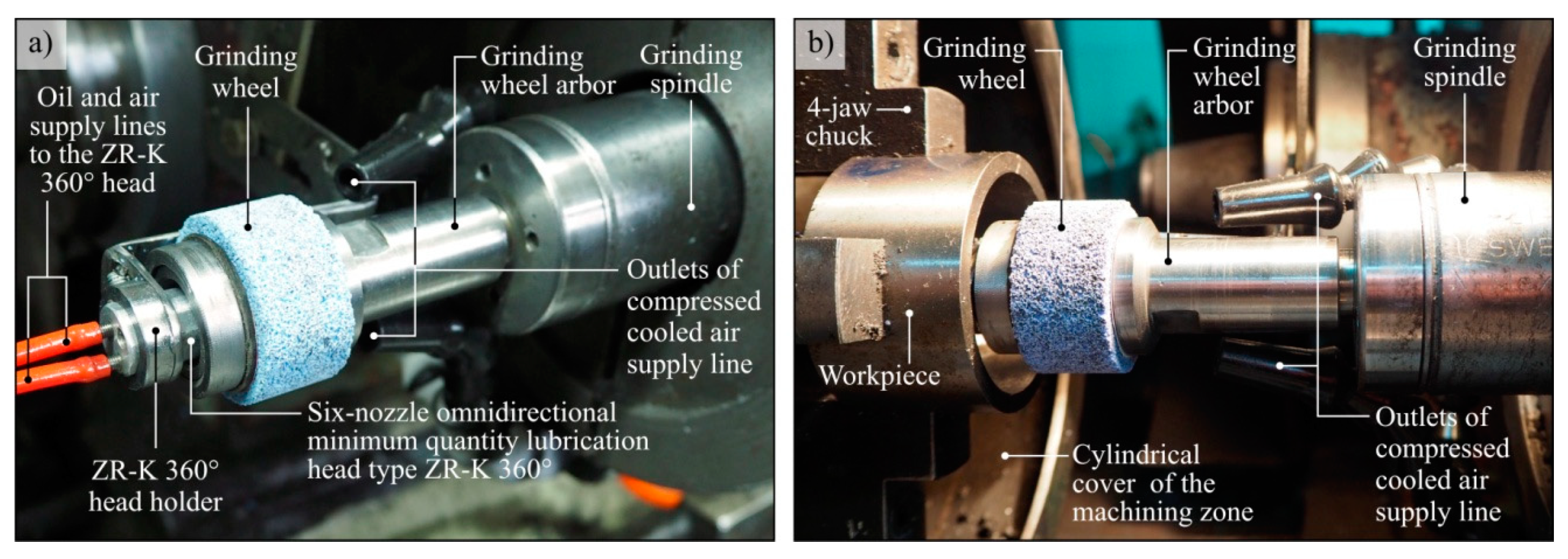
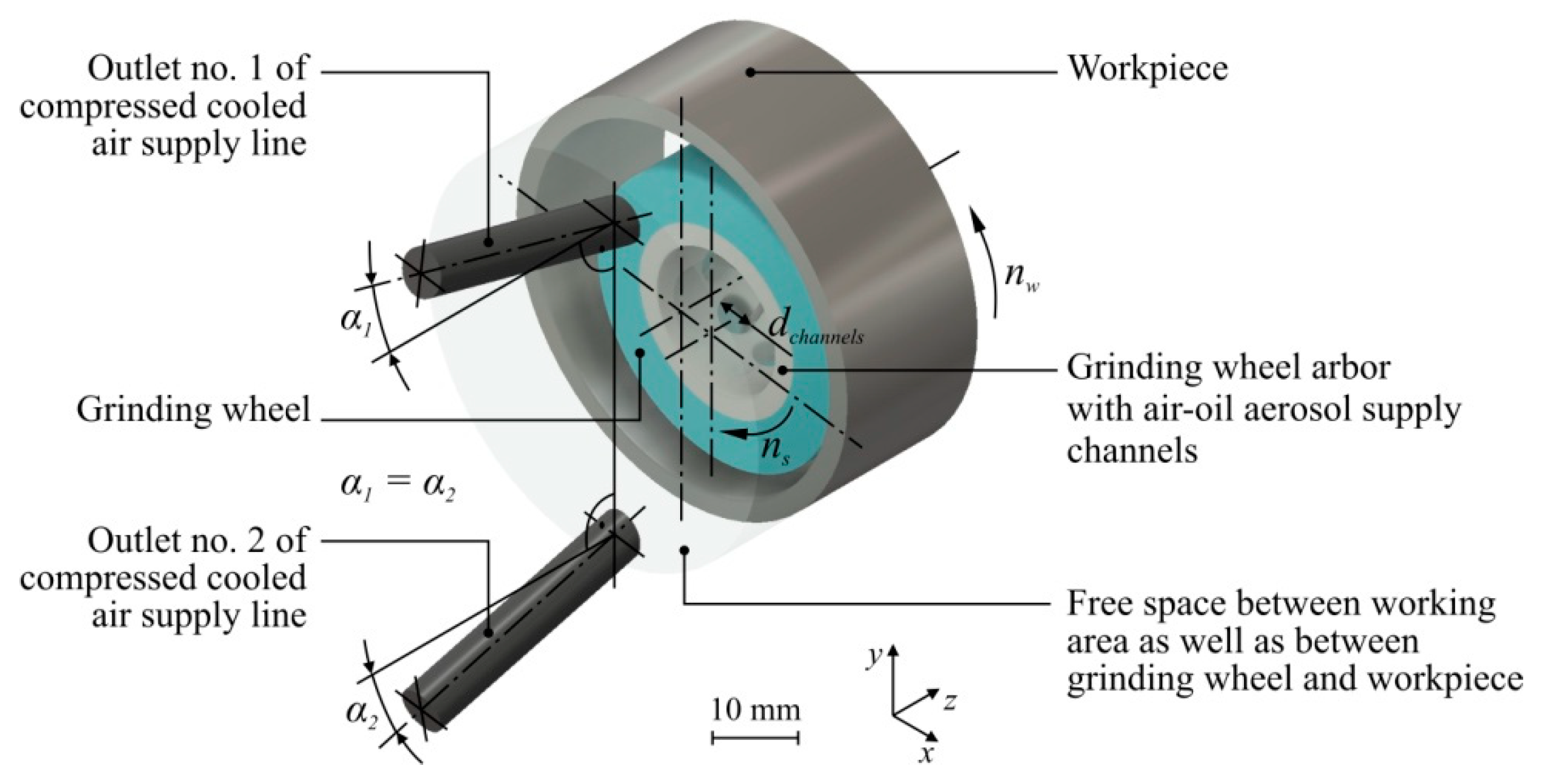
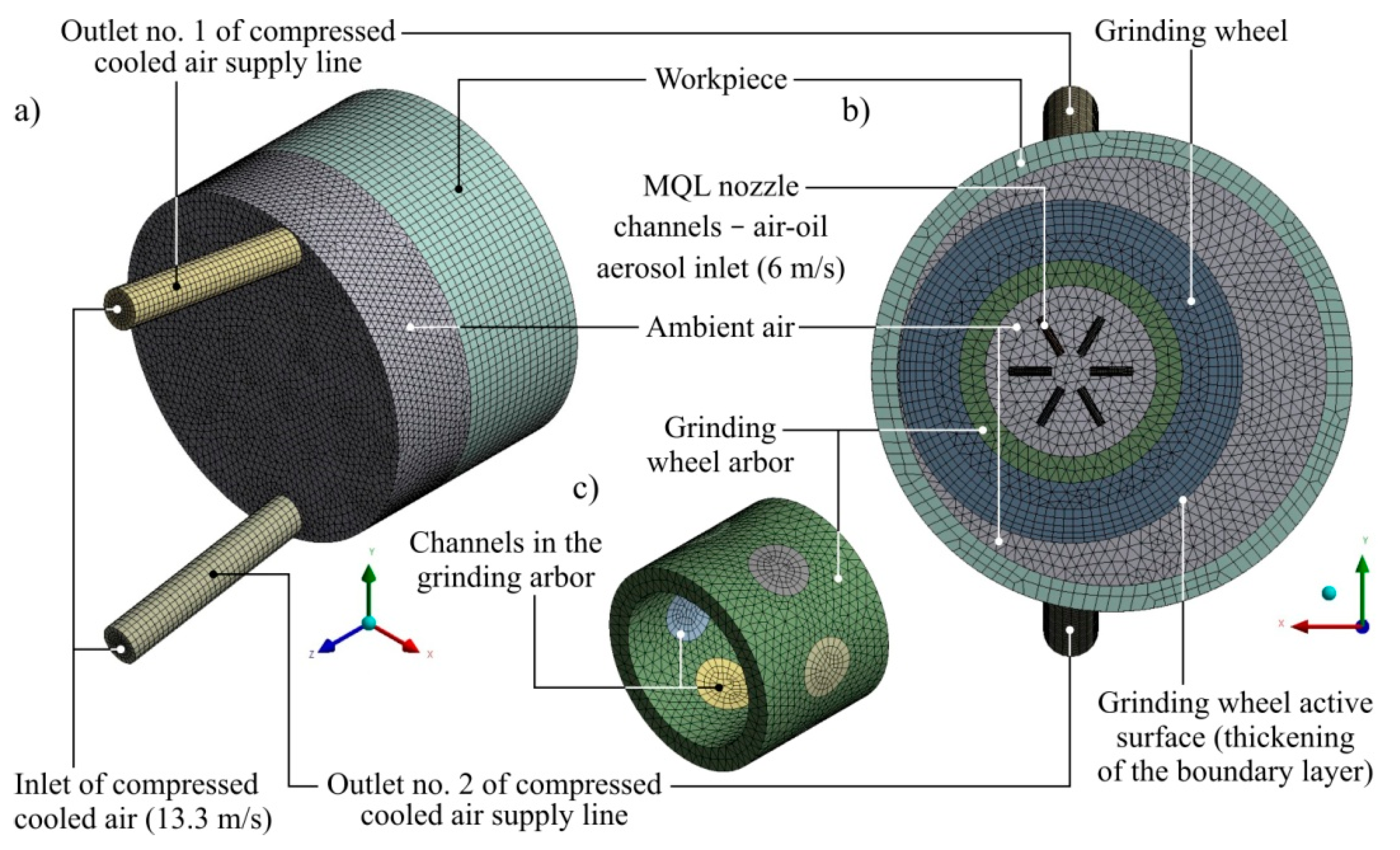
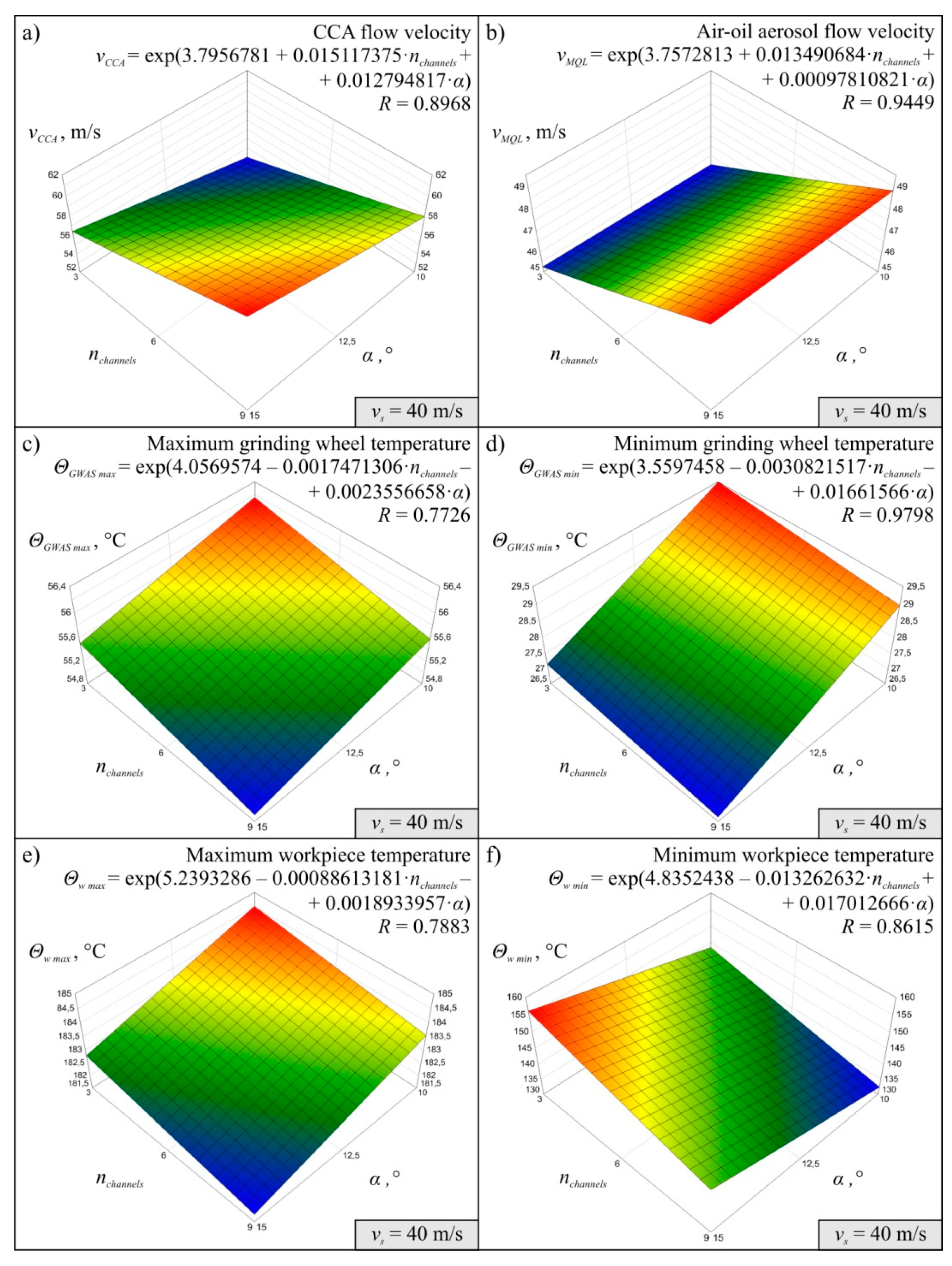
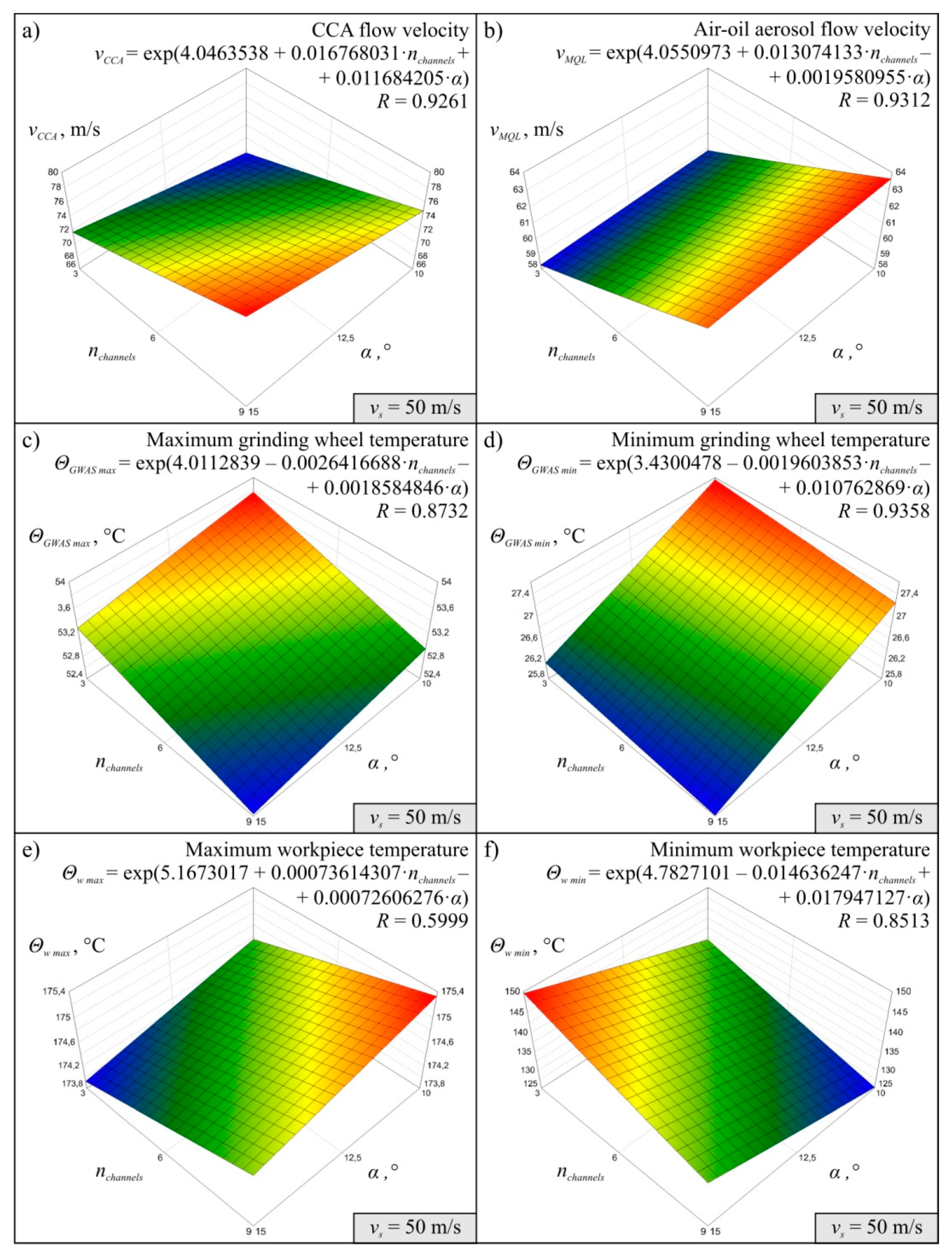

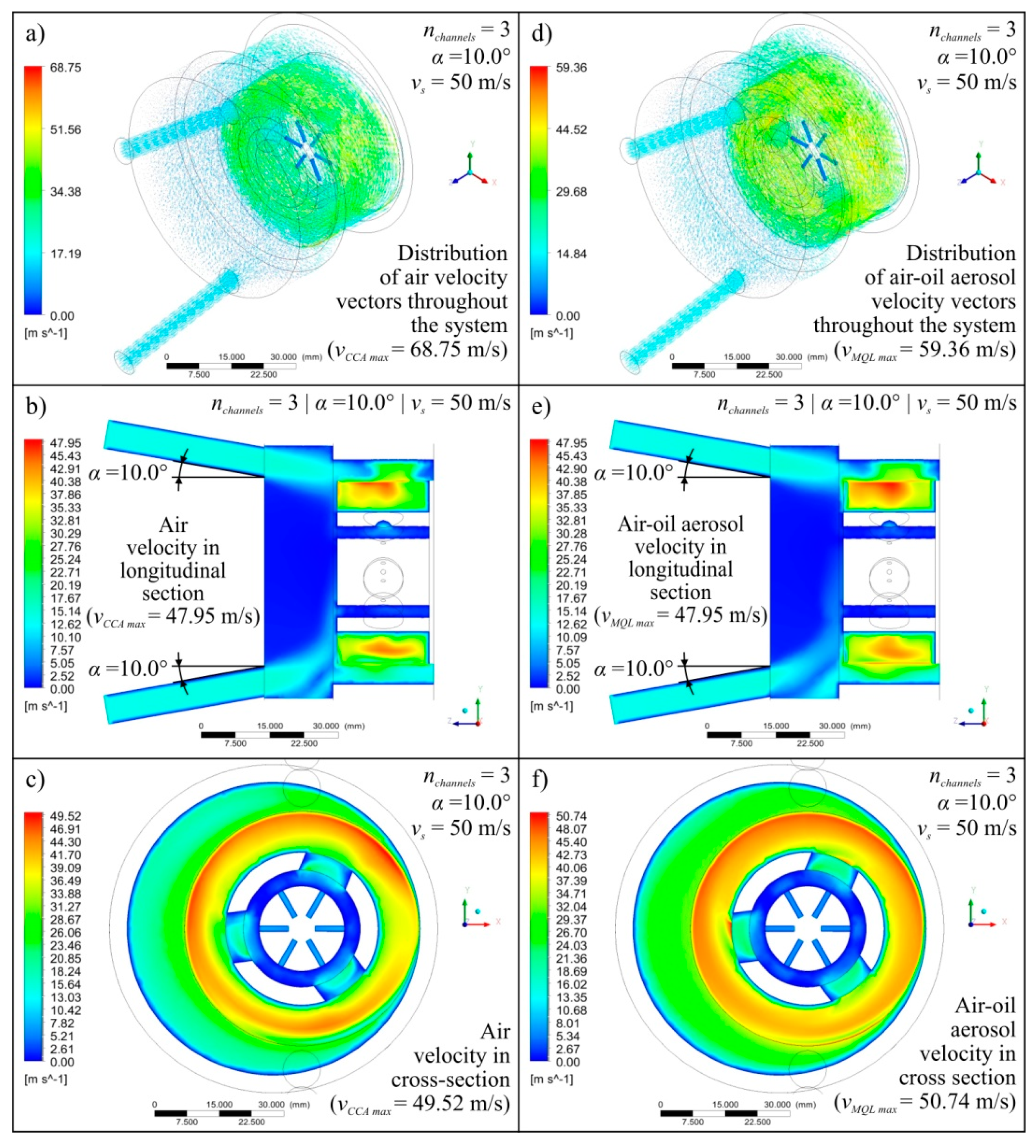
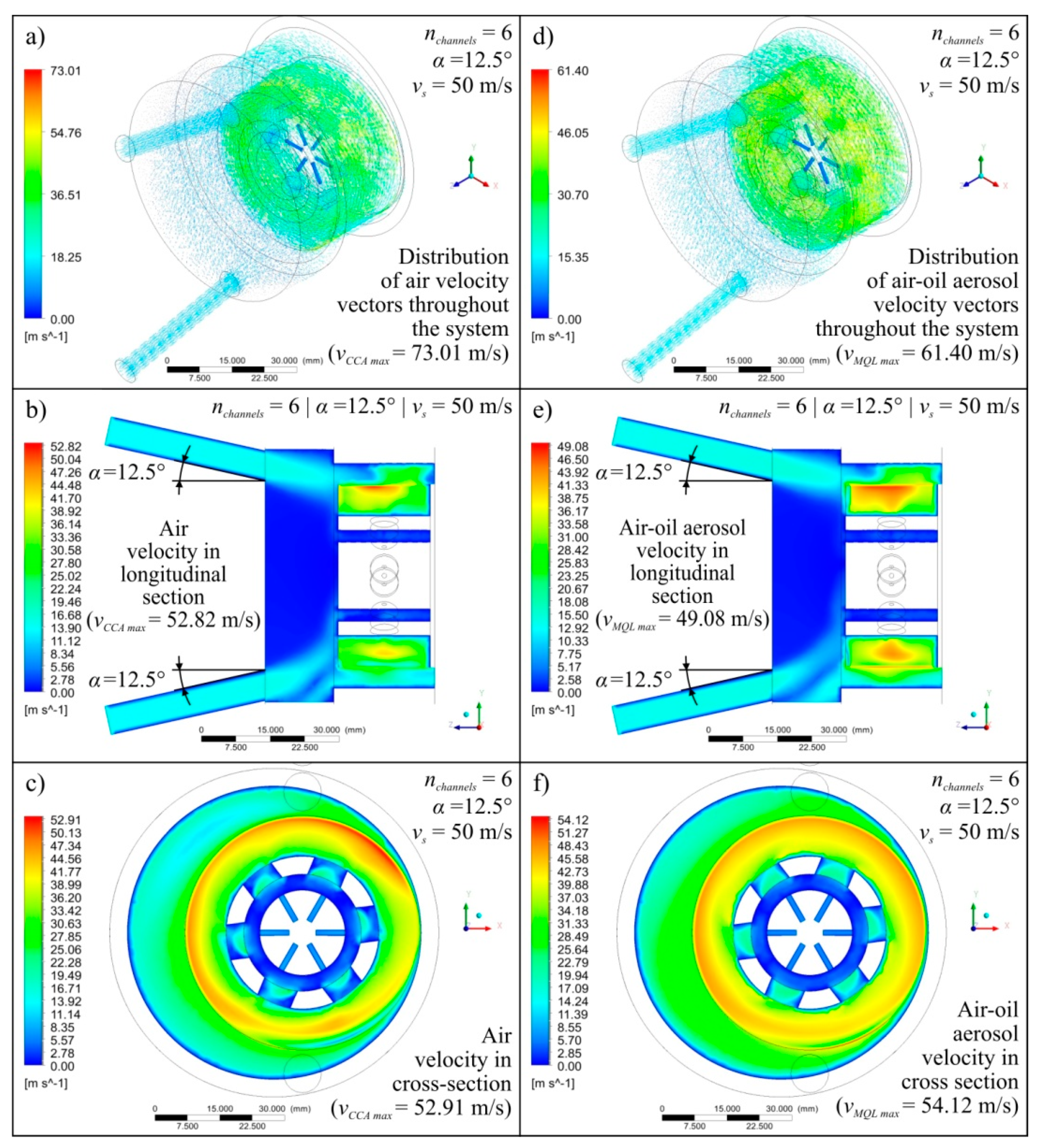
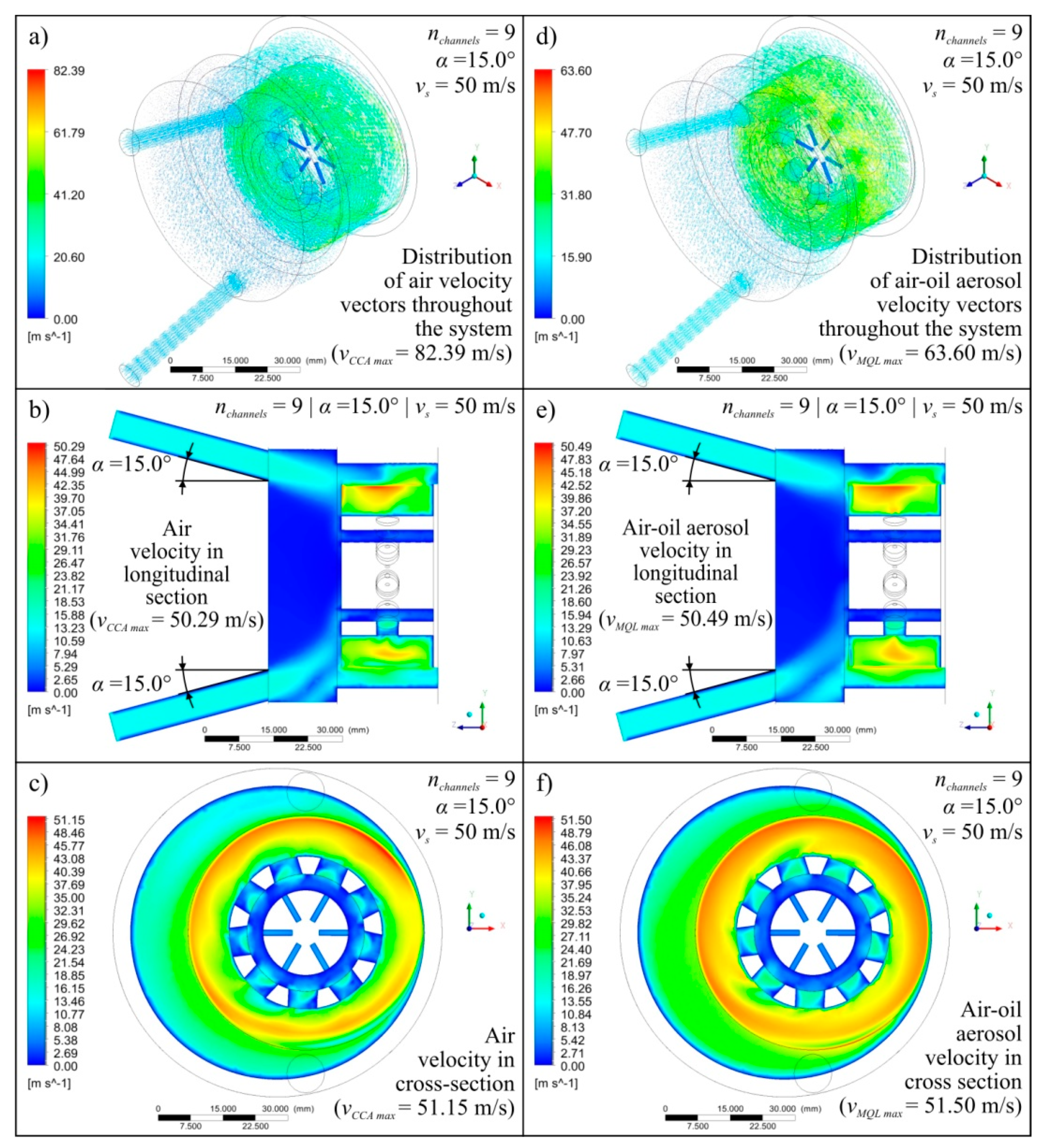
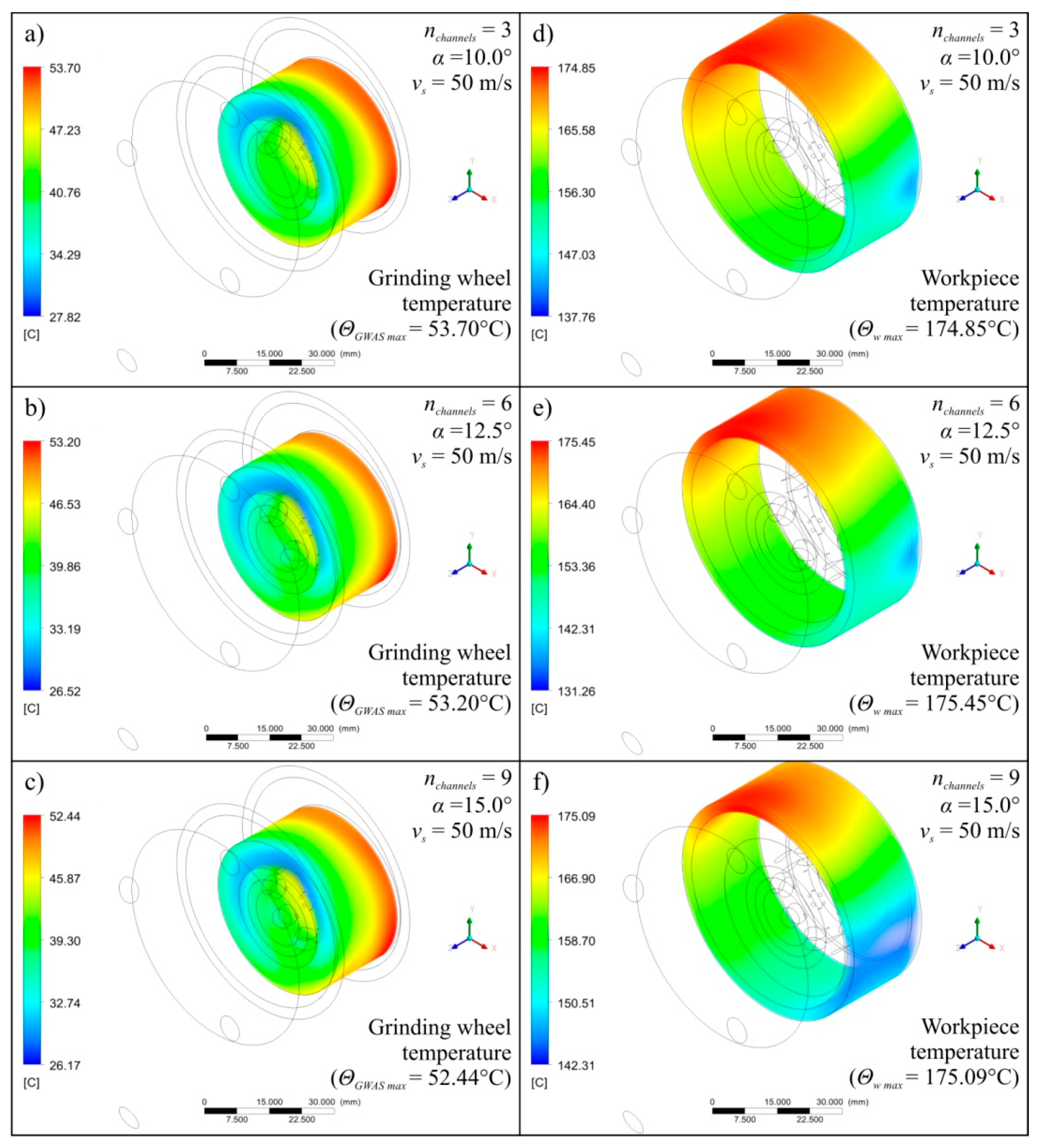
| Group of Prosperities | Property | Unit | Value |
|---|---|---|---|
| Physical | Poisson number | v | 0.30 (2) |
| Specific heat | J/kg·K | 475 (1) | |
| Density | kg/dm3 | 7.81 | |
| Thermal conductivity | W/m·K | 46.6 | |
| Electrical resistivity | Ω·mm2/m | 0.22 | |
| Electrical conductivity | S·mm2/m | 4.55 | |
| Mechanical | Thermal expansion | 10−6·1/K | 11.4 (1) |
| Modulus of elasticity | longitudinal GPa | 210 (2) | |
| tangential GPa | 80 (2) | ||
| Bulk modulus | GPa | 140 (2) | |
| Poisson number | v | 0.30 (2) |
| Assumptions | Total channel cross-sectional area in the grinding arbor Achannels = 176.7 mm2 for each of the geometrical variants under consideration |
| Grinding wheel offset from the workpiece surface by 0.2 mm | |
| The GWAS and the face of the grinding wheel are rough (RSGR = 0.425 mm) | |
| Only the main rotational movement of the grinding wheel and the basic feed movement (counter-rotation) of the workpiece are taken into account | |
| No impact of the environment on airflow and flow of air-oil aerosol | |
| The air has the properties of an excellent gas | |
| The air and air-oil aerosol mass is relatively low | |
| The heat exchange takes place through forced convection and heat conduction | |
| On the basis of exploratory thermovision measurements it is assumed that the heat source is the external surface of the grinding wheel (TGWAS = 80 °C) and the internal surface of the workpiece (Tw = 180 °C) | |
| The walls of the CCA supply line outlets and MQL nozzle outlets are insulated | |
| The grinding wheel material is Al2O3 with a porous structure | |
| Values vs were changed at the same time from vw with a constant value of the ratio q = vs/vw = 60 |
| Simplifications | The number of geometric simulation variants has been limited |
| Friction and contact issues between the GWAS and the workpiece surface are omitted | |
| All other walls are modelled as smooth | |
| Axial wheel feed vfa and radial wheel feed vfr have been omitted in order to simplify the system kinematics and shorten the time of simulation calculations | |
| Only the volume of the environment in the form of unhindered air is taken into account | |
| The intermolecular interactions are reduced only to repulsion at the moment of perfectly resilient collisions. The particles are in constant chaotic motion and their volume is negligible in relation to the gas volume. | |
| The effect of earth acceleration on the CCA flow in the system under consideration shall be ignored | |
| The contribution of radiation to the heat exchange case under consideration is ignored | |
| The influence of other possible heat sources, such as machine elements or room light sources, shall be ignored | |
| The heat exchange between the environment and the walls of the CCA supply line as well as MQL nozzle is ignored | |
| The share of the grinding wheel bond in the simulation is omitted |
| Geometric Parameters of the Model | Outer diameter of grinding wheel: ds = 40.0 mm | |||
| Internal diameter of the workpiece: dw = 50.0 mm | ||||
| Number of channels in the grinding arbor: nchannels = 3, 6, 9 | ||||
| Diameter of a single channel in the grinding arbor for air-oil aerosol delivery: dchannels = 5.00 mm; 6.12 mm; 8.66 mm | ||||
| CCA supply line diameter: 6.3 mm | ||||
| Angle of the CCA supply line outlet: α1 = α2 = 10.0°; 12.5°; 15.0° | ||||
| Discretisation Mesh Parameters of the Model | nchannels = 3 | α1 = α2 = 10.0° | 334972 elements | 92769 nodes |
| nchannels = 3 | α1 = α2 = 12.5° | 332469 elements | 91645 nodes | |
| nchannels = 3 | α1 = α2 = 15.0° | 331659 elements | 91361 nodes | |
| nchannels = 6 | α1 = α2 = 10.0° | 355312 elements | 97239 nodes | |
| nchannels = 6 | α1 = α2 = 12.5° | 349753 elements | 95381 nodes | |
| nchannels = 6 | α1 = α2 = 15.0° | 349561 elements | 95526 nodes | |
| nchannels = 9 | α1 = α2 = 10.0° | 367551 elements | 100119 nodes | |
| nchannels = 9 | α1 = α2 = 12.5° | 363216 elements | 98483 nodes | |
| nchannels = 9 | α1 = α2 = 15.0° | 362811 elements | 98615 nodes | |
| mesch | domain: fluid | min. size 0.1 mm | max. size 2 mm | |
| Properties of Liquids and Solids Used in the Simulation | Air | Model: ideal gas from the ANSYS® library | ||
| Morphology: fluid in continuous phase | ||||
| Oil | Model: defined Cimtech MQL oil model from Cimcool | |||
| Morphology: dispersed fluid (droplet size 0.002 mm) | ||||
| Steel (workpiece) | Model: default steel model from the ANSYS® library | |||
| Morphology: solid in continuous phase | ||||
| Al2O3 (grinding wheel) | Model: defined model: Al2O3 | |||
| Morphology: solid in continuous phase | ||||
| Workstation | Dell Precision T7500 Workstation (Intel Xeon X5690 3.47 GHz, 24 GB RAM) | |
| Operating System | Windows 7 Professional 64 bit | |
| Software | ANSYS® 18.1 | |
| Conditions of the Simulation Process | Type of analysis: steady state | |
| Time step for fluids: physical time step: 3 ×·10−5 s | ||
| Time step for solids: automatic | ||
| Computational time: 1.409 × 104 s (average) | ||
| Multi-phase model: two heterogeneous phases | ||
| Heat exchange model: total energy model | ||
| Continuous phase turbulence model: shear stress transport model | ||
| Dispersed phase turbulence model: model based on the dispersed phase zero equation | ||
| Reference pressure value: 101,325 Pa | ||
| Gravity influence model: no gravity influence | ||
| Degree of turbulence intensity: average (intensity 5%) | ||
| Flow condition: subsonic | ||
| Total volumetric flow rate of CCA: QCCA = 0.00083 dm3/s | ||
| CCA feed rate: vCCA = 13.3 m/s | ||
| Grinding wheel peripheral speed: vs = 40 m/s, 50 m/s, 60 m/s | ||
| Workpiece peripheral speed: vw = 0.67 m/s, 0.83 m/s, 1.00 m/s | ||
| Ambient air start temperature: 18 °C | ||
| Supply CCA temperature: –5 °C | ||
| Grining wheel (Al2O3) | Heat transfer coefficient: 300 W/m2·K Outer limit temperature: 18 °C Heat source: flux of 55,000 W/m2 Thermal conductivity: 38.5 W/m·K Volumetric heat capacity: 39.1 × 102 J/dm3·K | |
| Workpiece (steel) | Heat transfer coefficient: 100 W/m2·K Outer limit temperature: 18°C Heat source: flux of 45,000 W/m2 Thermal conductivity: 60.5 W/m·K Volumetric heat capacity: 33.9 × 102 J/dm3·K | |
© 2020 by the authors. Licensee MDPI, Basel, Switzerland. This article is an open access article distributed under the terms and conditions of the Creative Commons Attribution (CC BY) license (http://creativecommons.org/licenses/by/4.0/).
Share and Cite
Kieraś, S.; Jakubowski, M.; Nadolny, K. Simulation Studies on Centrifugal MQL-CCA Method of Applying Coolant during Internal Cylindrical Grinding Process. Materials 2020, 13, 2506. https://doi.org/10.3390/ma13112506
Kieraś S, Jakubowski M, Nadolny K. Simulation Studies on Centrifugal MQL-CCA Method of Applying Coolant during Internal Cylindrical Grinding Process. Materials. 2020; 13(11):2506. https://doi.org/10.3390/ma13112506
Chicago/Turabian StyleKieraś, Seweryn, Marek Jakubowski, and Krzysztof Nadolny. 2020. "Simulation Studies on Centrifugal MQL-CCA Method of Applying Coolant during Internal Cylindrical Grinding Process" Materials 13, no. 11: 2506. https://doi.org/10.3390/ma13112506
APA StyleKieraś, S., Jakubowski, M., & Nadolny, K. (2020). Simulation Studies on Centrifugal MQL-CCA Method of Applying Coolant during Internal Cylindrical Grinding Process. Materials, 13(11), 2506. https://doi.org/10.3390/ma13112506






